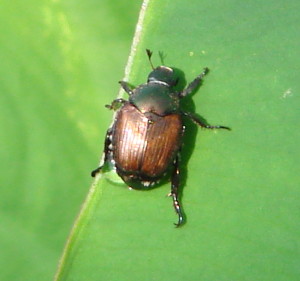Hello fellow readers, One of the notable things about our chats is the cycle of gardening dilemmas each year. It’s Japanese beetle time, and they must be out in full force based on all who have asked what to do. Last year we talked about the store-bought Japanese beetle bags and how their pheromone lures attract more beetles into your yard. Maybe a gift idea for your neighbor? Smile. To follow are more effective Japanese beetle controls.
Rebecca of Andover, who’s in the last stages of a backyard renovation, writes, ‘Japanese Beetles are already swarming us. What can I spray to protect the plants while keeping them safe for bees and butterflies?’ I shared my nostalgia for a jiffy jar of beetles. Good old mom hired her 5-pack to fill for 5 cents a jar.
It turns out handpicking, especially early in the beetle season, is one of the most impactful first lines of defense. Japanese beetles themselves emit a pheromone lure that draws kinfolk to their feeding spot. Patti Doell, who owns Little Big Farm (an organic flower farm in Blairstown), cuts off the parts of the plant infested even if in bloom to prevent other beetles from joining the party.
Milky Spore is a safe, all-natural biological control using milky disease spores, lethal to grubs but harmless to humans, pets, and beneficial insects. The bacteria live in the soil for 10 to 15 years and can be applied anytime the ground is not frozen.
True Milky Spore is a long-term remedy and not an immediate hit to the current population. So catch as many as you can. Then you can throw a second punch using Neem Oil if you wish. They say it’s not harmful to beneficial bugs as “good bugs” don’t ingest leaves, but you still need to be careful when spraying as any spray can suffocate insects. Hence, best to apply first thing in the morning or late in the evening when pollinators are least active.
Early morning is the best time to catch Japanese Beetles as they are sluggish then and will easily fall into your jar or bucket. It’s what to do with your catch that always leaves me a bit queasy. You can drown them in soapy water or use plain water so you can feed them to your chickens or pond fish. Or ‘Cook the Suckers’ Mom used to say as she tossed them into boiling water (out of character, really as she’s normally compassionate about critters). Somehow a treasured Japanese maple disrespectfully defoliated by beetles with the same heritage changes things.
Garden Dilemmas? AskMaryStone@gmail.com (and your favorite Podcast App.)
Link to related column – Japanese Beetle Time
Link to Little Big Farm
Column Updated 7/18/21



